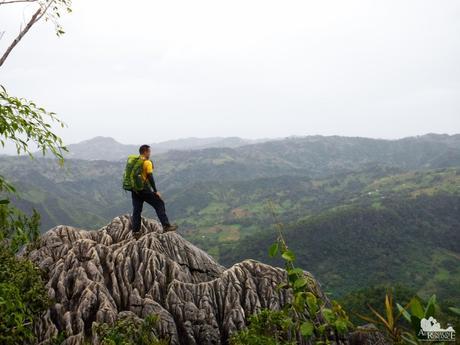
The mountains of Cebu are not remarkably tall. In fact, their pinnacles punch through the 1,000-meter mark by a mere few meters. But that doesn’t mean they are less magnificent that other peaks in the country. Our mountains are absolutely fascinating. They radiate their own unique magic, and they have their own beautiful stories to tell. Thus, one overcast weekend, we went out and listened to the tales of rocky Mt. Mauyog in Balamban, Cebu.
My colleague Tolits invited me and Sweetie to join his group, Bukal Outdoor Club, for a weekend climb up Mt. Mauyog and the nearby Mt. Manunggal. Together with our daughter Alexa and our close adventure friends Angel and Apol, we agreed with no hesitation. Our group met with theirs early at JY Square where we rode a chartered jeepney to Barangay Tabunan.
We arrived at Barangay Tabunan at around 8 AM. While waiting for the others to complete their last-minute shopping, I got amused by this funny street spectacle. These four stray dogs nibbled the ticks and lies off each other. Our little Polly does that too but only to herself. But to each other?
I don’t know, but seeing them helping each other was hilarious. And it also made us realize that just like animals, animals also want to help each other out in whatever small way they can.
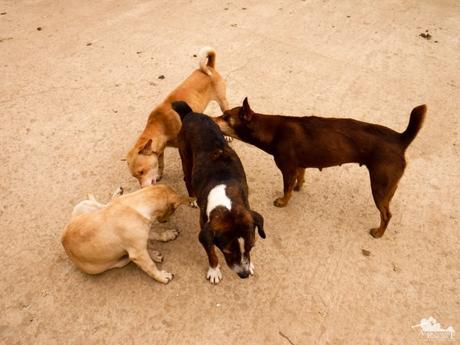
After registration and paying our fees (we’ll tell you more about this later), it was time to start the trek. The first hurdle was to cross the Lusaran River, which can swell to unfordable width and strength during heavy rain. Slowly, we waded to the other side of the river; we had to be careful because the current was quite strong even if the water was shallow.
The river serves as a natural boundary between the municipality of Balamban and Cebu City.
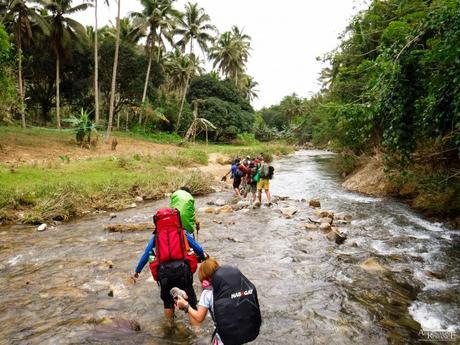
Locals quarry the river for sand and gravel, which are then used as construction materials. The quarrying seems to be small in scale, but it has a significant impact on the river. Parts of the riverbanks have eroded; the depth of the river has changed, and we’re pretty sure that somewhere out there, the natural flow has been diverted.
For us, this is an eye-opener. The effect of quarrying is relatively significant compared to its scale. Now, imagine if the activity is huge in scale, that is, companies huge machines and dump tracks to excavate the gravel and soil. Large-scale quarrying has killed and stopped the flow of Mananga River, once the largest river in Cebu.
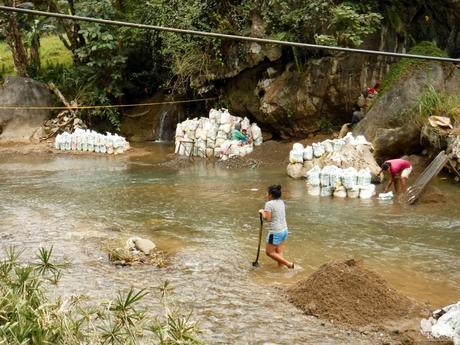
Lusaran River is among the few remaining environmentally viable river systems in Central Cebu. Rivers form an important part of our ecosystem. They make the surrounding soil moist and healthy, supply the lowlands with fresh and potable water, carry natural waste and silt off the land, and more. Pollution, deforestation, and quarrying negatively affect, and even destroy, these beautiful rivers. Let us not kill any more of Cebu’s rivers.
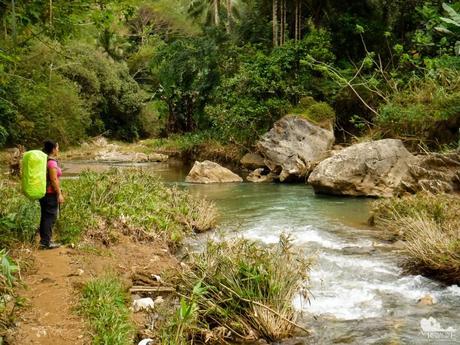
After drying our feet—you don’t want to be walking with wet shoes—we started our ascent from the base of the mountain range. The moderately steep route follows a farmers’ trail, which snakes up a relatively gentle angle of the mountain’s slope. There were no exceptionally steep sections, but there were no completely flat sections either.
We passed by coconut grooves and small banana plantations on our way to Mt. Mauyog’s summit.
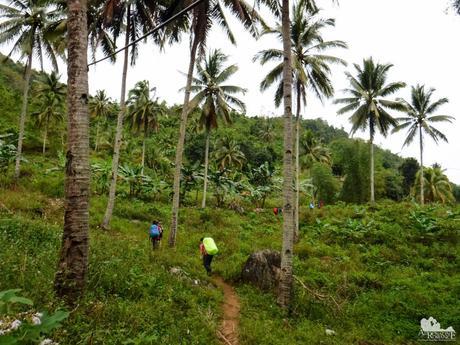
As we climbed farther, small communities, some consisting of less than a dozen houses, clung to the mountainside. It is quite a revelation to know that these hardworking residents climb up and down the mountain all day long as part of their daily lives. These humble people are way stronger and more resilient than us even if we label ourselves as trekkers or mountaineers.
Look at that green scenery! Cebu’s mountains, despite heavy deforestation, still have thick patches of canopies.
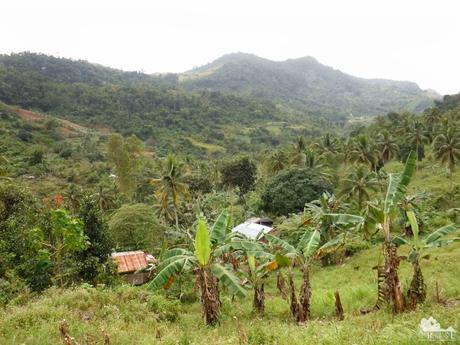
Small to medium-sized farms dot the slope. These farms provide households with healthy, naturally grown, and organic foodstuff. They also provide them with income; harvested crops are brought down and sold in the market.
Due to ideal conditions such as fertile soil, clean air, and cool climate, mountains are excellent for cultivating vegetables, fruits, and flowers that may otherwise grow poorly in the lowlands.
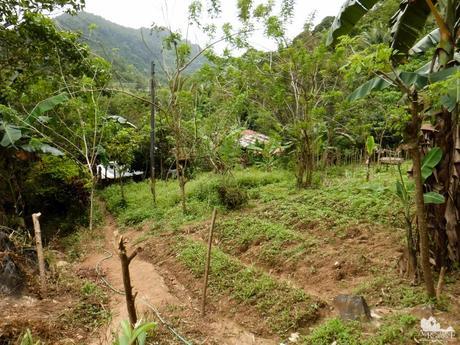
A vast number of Filipino farmers are quite hesitant to adopt new technologies and methods to obtain a bigger and better yield. Most of them are resistant to change. Well, who can blame them considering that their knowledge of farming has been passed on to them since their ancestors?
For example, rather than machinery, farmers still use cows and carabaos to plow the field or haul cargo. No need to buy fuel; just let the animals roam around to eat grass and foliage for food. According to a farmer I interviewed along the way, they view their cows and carabaos more like pets than beasts of burden.
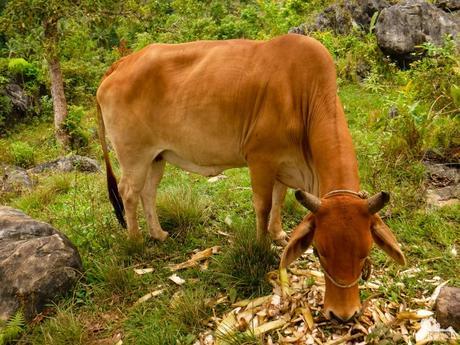
A little over an hour, we reached a large clearing where we stopped for a few minutes to rest and catch our breaths. From here, we could see the immensity of the range that comprises Mt. Mauyog and Mt. Manunggal. From our point of view, the mountain seems to be made of limestone, which is abundant in the tropics. Thus, a large part of the range is actually a karst formation covered with dense vegetation. Look at that thick, healthy jungle just in front of me.
Climbing mountains means that we need to carry provisions, equipment, shelter, and a small degree of convenience with me. Good thing I have my sturdy, comfortable, and reliable Deuter ACT Lite, which keeps all my gear safe and within reach.
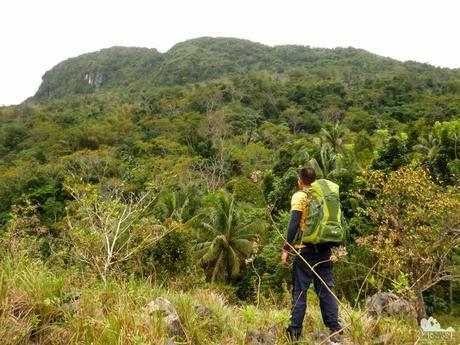
Weekend climbs become amazing and memorable adventures with the uber-awesome trekkers from Bukal Outdoor Club! We were happy that Sir Tolits invited us to join their weekend sojourn.
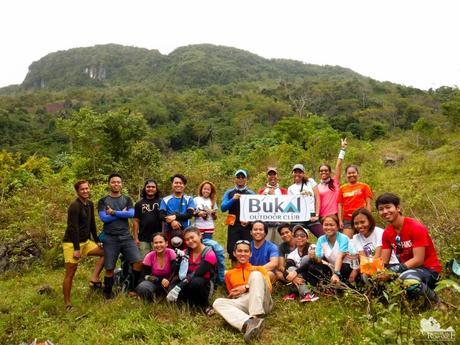
As we went on, we came across grassy “bowls” such as these. They form nice meadows for cows, goats, and other farm animals to graze in.
These are also training grounds for roosters who will one day be fighting for their lives in the national bloodsport of cockfighting. I was told that cockerels (roosters that are less than a year old) are often released here for a week or two as some sort of “ritual” to roosterhood. Cockerels face harsh elements, hunt for food, and fight for survival. Those that are deemed nakapasar (i.e., survived in the wild) are said to be stronger, more aggressive, and more resilient than their commercial, non-ritualized counterparts. Thus, these tough roosters are thought to have a bigger chance of winning a cockfight.

Houses, sheds, watering holes, and other secrets hide in the thick grove of trees. We shared the trail with a smattering of goats and cows who contentedly chewed their cud, oblivious to our presence.
As approached the crest of this hill near noontime, we heard the sounds of civilization—booming disco music, wild laughter of men who have one drink too many, the angry buzz of motorcycles revving to life. A number of children ran downhill, some playfully colliding with the trekkers who were working their way above. What’s going on here?
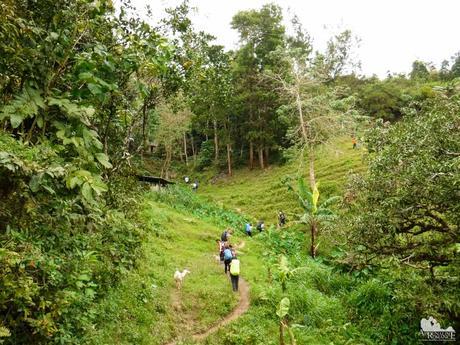
We reached Barangay Sunog, which marked the midway point of today’s trek and the venue for our lunch. We chose to eat here because there are sari-sari stores that sell cold softdrinks, snacks, and other supplies that may be needed in the campsite.
It turned out that the barangay was celebrating its annual fiesta; that was what the din was all about! Even better, some of the residents offered us some lechon, bam-i, and other fiesta food to supplement our packed meals! We love unexpected surprises like these. Invitations to a meal or a drink is a signature trait of warm and friendly Filipinos.
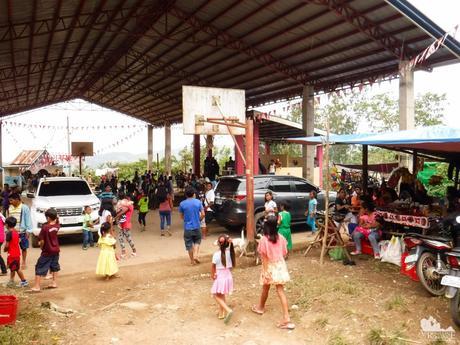
Cockfighting is popular pastime in the Philippines. It is a blood sport that involves two roosters fighting to the death. Sharp spurs are fastened to the rooster’s legs to increase the lethality of the blows. Think of the game as a sword fight between two roosters that are specially bred for increased stamina, strength, and aggression.
Cockfighters take extremely good care of their roosters. The birds are given the best supplements, vitamins, drugs, and lots of tender loving care. Filipinos often joke that cockfighting enthusiasts caress their roosters more than they caress their wives!
As we prepared to move out, an afternoon tigbakay began. A tigbakay is a small-time, technically illegal cockfighting game, usually played out anywhere where there is an open space. Like many things in this country, the illegality is often overlooked. On the other hand, an officially sanctioned game is called a derby and is held in a cockfighting arena. People bet, win, and loose thousands or even millions of pesos in derbies.
The roar of a hundred men calling out their bets reverberated in the open-air stadium and beyond.
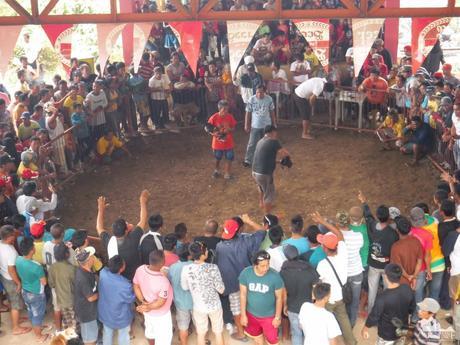
By the time we finished our lunch, we were so full that we could hardly walk. But walk we should for the summit is near. We hiked on a slanting concrete road between sloping farms and thick jungles.
Locals eyed us bemusedly; who are these people who are carrying huge, colorful backpacks? Couldn’t they just hired a habal-habal to get them to the top? They would have shaved a huge chunk of time and effort.
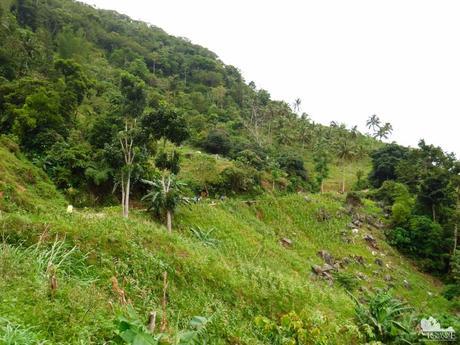
Soon, we left the concrete road—thank heavens—and began our assault on Mt. Mauyog’s summit. The first part of the trail was marked with firm soil and roots. But as we neared the peak, sharp and slippery moss-covered rocks began to dominate the trail.
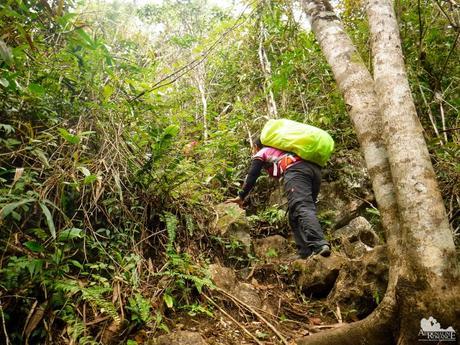
At times, we had to carefully climb over huge boulders, often on all fours. Surprisingly, we like this kind of trail; it allows us to use all our limbs, not just the legs. That’s one of the reasons why we fell in love with Mt. Guiting-guiting, one of the toughest mountains in the Philippines. Trails like these play to our preferences and strengths.
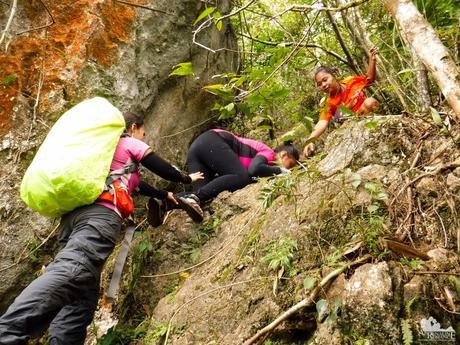
We fought our way through sharp blades of grass, thorny branches, and thick ferns. We also need to watch out steps or do a balancing over the razor-sharp rocks. A slip on either side of these rocks can be injurious.
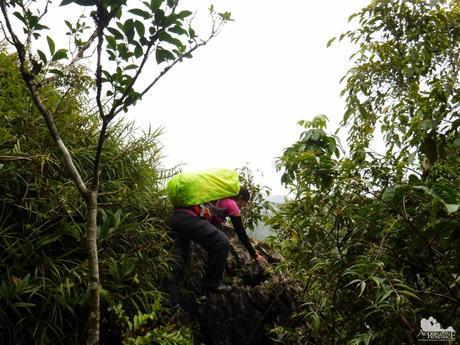
At last, we stepped on Mt. Mauyog’s sacred summit where we could see the green glory of Balamban right before us. As usual, we felt the mountain’s spirit smile upon us as we breathed in the wonderful scenery.
The steep, rocky summit and the tiny peak area meant that it was impossible to stand on our two feet. We had to sit down on the pinnacle itself, and it’s sharp on the butt! Hehehehe! Sweetie had to stand on tiny footholds.
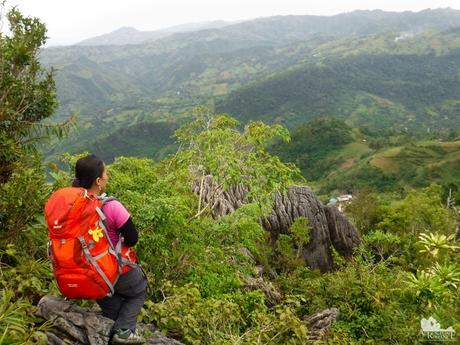
At less than 1,000 meters above sea level, Mt. Mauyog isn’t exactly a tall mountain. Nor is it one that we categorize as challenging (well, at least at our level of climbing experience). However, its peak offers one of those life-lesson views that let us realize how insignificant we are in the shadow of nature. Yes, there are dozens of communities all around, but they are all dwarfed by the sheer size of this mountain range.
Yet, for all our minuscule position, homo sapiens are responsible for the biggest, most obvious, most far-reaching, and most significant effects on the environment, both in local and global scale. From the summit of Mt. Mauyog, we can see how our forests were razed decades ago to make way for farms and towns.
Human development is unceasing—and needed—to support a growing population and nourish a modern civilization. But the question is, how much human development can the world sustain before its repercussions cause us to destroy ourselves?
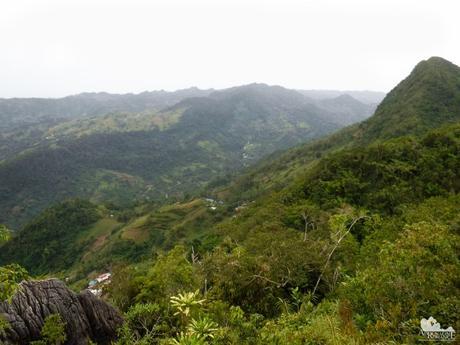
The crown jewel of Mt. Mauyog is the large brain-like promontory below the summit. Care should be taken in standing here because there are dangerous hundred-foot drops surrounding the formation.
The brain-like formation suggests two plausible origins. One, the well-defined channels and trenches are the result of thousands of years of wind and water erosion. Two, the peak must have been underwater millions of years ago when the sea level was much higher.
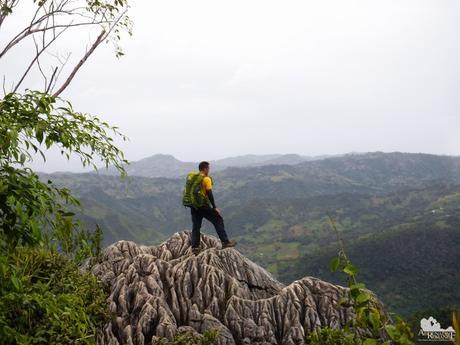
After taking a few photos, we took a short walk to the other side of the summit. This rocky promontory has a much bigger area, which can accommodate a number of people. It seems that this secondary peak is a favorite place for locals and visitors of the mountain to hang out.
Our hearts though were skipping beats as we saw these young visitors scrambled up and down the outcroppings, oblivious to the real danger of falling off the deadly chasms all around them.
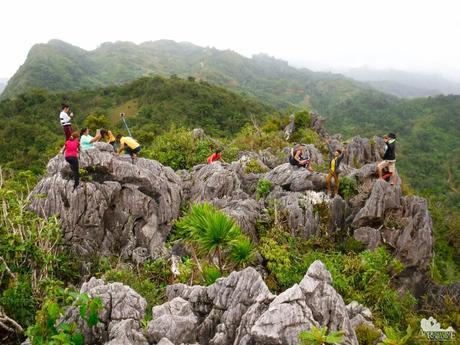
Every day, we are constantly bombarded with all forms of doubts, insecurities, disappointments, and worries. Collectively, these negatives can truly push and beat you to the ground. But the human spirit is indomitable. When you harness your courage, determination, and willpower, you can accomplish all goals you’ve set for yourself. You can overcome all problems that beset you. But you have to be willing to take the falls, to endure hardships, to sweat and gut it out, to fail repeatedly.
It is when you step on our own summit that you can look back and realize that you always have been stronger and better than you thought you were. Most importantly, right beyond you is a whole new world of exciting challenges that you want to welcome. You will realize that you are truly unstoppable.
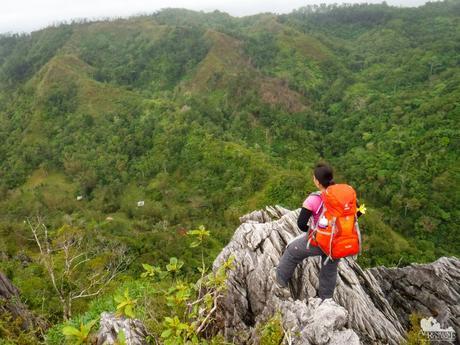
The mountains of Cebu are not that tall. Yet, they have so as much heart and soul as their taller counterparts. Their slopes carry the memories, songs, and lessons of time. You just need to close your mouth; and open your eyes, ears, and heart.
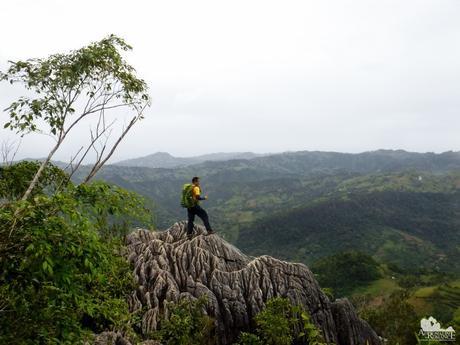
Watch out for our next blog post about our adventure in Mt. Manunggal. Itineraries, budgets, and other important information will also be published in our next blog post.
An Important Word About Tabunan’s and Sunog’s So-Called Fees
Bear with us with this long narrative, but we feel each one who wants to climb Mts. Mauyog and Manunggal through the Tabunan-Sunog trail must know this.
All visitors are willing to pay the necessary fees to climb a mountain. However, they don’t want to be taken advantaged of just because they are visitors. Unfortunately, for some unscrupulous residents in Barangays Tabunan and Sunog, trekkers entering Mts. Mauyog and Manunggal through their land are thought of as targets of financial opportunity.
They demand P 60 per climber as an entrance fee and another P 300 for a mandatory guide fee. These rates change depending on how they look at hikers, sometimes reaching up to P 700 per guide. Just to compare, the guide fee for climbing Mt. Kanlaon, which is a major climb, is P 750 per day. At times, they don’t collect fees as iterated by Sir Jing during his Cebu Highlands Trail thru-hike.
Now, the trail to Barangay Sunog is simply a farm trail that is used everyday by residents. It is not a true mountain trail where rangers and caretakers constantly clean and clear it, which understandably requires a maintenance fee. Also trekkers who have been here before know the way up. First timers can also ask locals for directions. In other words, considering the ease of the trail, guides are not really warranted.
In Barangay Sunog, there is another “entrance fee” at P 20 per person and a guide fee at P 200 per group to climb Mt. Mauyog. This doubles the fee; trekkers have already paid their dues down in Barangay Tabunan. When a friend of ours asked for an official ordinance, the resident told him that it is a “donation” because the “owner” of Mt. Mauyog (can anyone actually own a mountain?) needs the money for his dialysis. We also found out that Barangay Sunog and Tabunan have an altercation about the collection of fees.
The so-called guides are actually farmers and—believe it or not—children who don’t know squat about mountaineering, wilderness knowledge, first aid, emergency protocols, etc. They don’t have any equipment or the necessary skills for standard guideship let alone rescue someone in need. In other words, they just know the way around the place and absolutely nothing else.
We have brought up the matter to Cebu Provincial Tourism Head Boboi Costas who, in turn, met with the tourism officer in Balamban. According to Mr. Costas and the tourism officer, there is no official ordinance that requires both barangays to collect fees of ANY kind. There is no official ordinance for mandatory guide services. If you wish to avail of a guide, you can negotiate for a reasonable fee. Monetary contributions to the LGU are appreciated but NOT required.
Mr. Costas and the TO surmised that those who are collecting fees are land owners and, sadly, unscrupulous local government officials. They have reportedly brought the matter to higher-ups so that these unfair activities should be stopped.
Mr. Costas gives the following advice: if people start asking you for “fees” if you are hiking the Tabunan trail or climbing Mt. Mauyog, ask them to show a official and signed ordinance from the Cebu Province that authorizes them to collect fees. Such document should bear the seal of the Cebu Provincial Government. Furthermore, they should be able to give you an official receipt. If they can do neither, then you are NOT obligated to pay.
If the collector persists or threatens you, you are advised to record the event and report it to the Cebu Provincial Government. You can use the following contact details:
- Street Address: Cebu Provincial Government, Capitol Site, Cebu City
- Phone Number: (032) 236-7672
- Email: [email protected]
- Facebook Page: Cebu Provincial Government
- Website: Cebu Provincial Government
You can also bring the matter up to the Tourism Office in the same address above. Use the following contact details
- Phone: (032) 253-5642
- Email: [email protected]
- Facebook Page: Sugbu Turismo
Save
Save
Save
Save
Save
Save

